
Megara is a historic town and a municipality in West Attica, Greece. It lies in the northern section of the Isthmus of Corinth opposite the island of Salamis, which belonged to Megara in archaic times, before being taken by Athens. Megara was one of the four districts of Attica, embodied in the four mythic sons of King Pandion II, of whom Nisos was the ruler of Megara. Megara was also a trade port, its people using their ships and wealth as a way to gain leverage on armies of neighboring poleis. Megara specialized in the exportation of wool and other animal products including livestock such as horses. It possessed two harbors, Pagae to the west on the Corinthian Gulf, and Nisaea to the east on the Saronic Gulf of the Aegean Sea.

Pythagoras of Samos was an ancient Ionian Greek philosopher and the eponymous founder of Pythagoreanism. His political and religious teachings were well known in Magna Graecia and influenced the philosophies of Plato, Aristotle, and, through them, Western philosophy. Knowledge of his life is clouded by legend, but he appears to have been the son of Mnesarchus, a gem-engraver on the island of Samos. Modern scholars disagree regarding Pythagoras's education and influences, but they do agree that, around 530 BC, he travelled to Croton in southern Italy, where he founded a school in which initiates were sworn to secrecy and lived a communal, ascetic lifestyle. This lifestyle entailed a number of dietary prohibitions, traditionally said to have included vegetarianism, although modern scholars doubt that he ever advocated for complete vegetarianism.
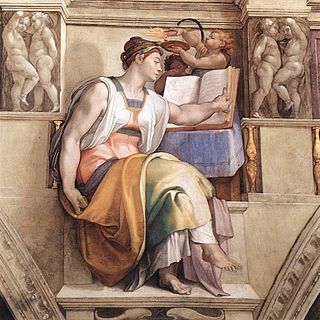
The Erythraean Sibyl was the prophetess of classical antiquity presiding over the Apollonian oracle at Erythrae, a town in Ionia opposite Chios, which was built by Neleus, the son of Codrus.
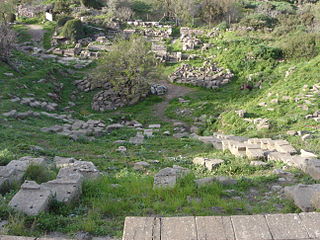
Erythrae or Erythrai later Litri, was one of the twelve Ionian cities of Asia Minor, situated 22 km north-east of the port of Cyssus, on a small peninsula stretching into the Bay of Erythrae, at an equal distance from the mountains Mimas and Corycus, and directly opposite the island of Chios. It is recorded that excellent wine was produced in the peninsula. Erythrae was notable for being the seat of the Erythraean Sibyl. The ruins of the city are found north of the town Ildırı in the Çeşme district of Izmir Province, Turkey.

The sibyls were female prophets or oracles in Ancient Greece. The earliest sibyls, according to legend, prophesied at holy sites. Their prophecies were influenced by divine inspiration from a deity, originally at Delphi and Pessinos. In Late Antiquity, various writers attested to the existence of sibyls in Greece, Italy, the Levant, and Asia Minor.

Lamia, in ancient Greek mythology, was a child-eating monster and, in later tradition, was regarded as a type of night-haunting spirit (daemon). In the earliest stories, Lamia was a beautiful queen of Libya who had an affair with Zeus. Upon learning this, Zeus's wife Hera forced Lamia to eat her own children, the offspring of her affair with Zeus, and afflicted her with permanent insomnia. Zeus, taking pity on her, endowed Lamia with the gift of prophecy and the ability to temporarily remove her eyes to relieve her sleeplessness.
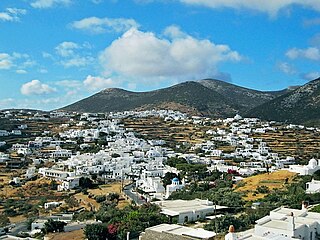
Sifnos is an island municipality in the Cyclades island group in Greece. The main town, near the center, known as Apollonia, is home of the island's folklore museum and library. The town's name is thought to come from an ancient temple of Apollo on the site of the church of Panayia Yeraniofora. The second-largest town is Artemonas (800), thought to be named after an ancient temple of Apollo's sister-goddess Artemis, located at the site of the church of Panayia Kokhi. The village of Kastro (118), was the capital of the island during ancient times until 1836. It is built on top of a high cliff on the island's east shore and today has extensive medieval remains and is the location of the island's archeological museum. The port settlement, on the west coast of the island is known as Kamares (245).

The Persian Sibyl - also known as the Babylonian, Hebrew or Egyptian Sibyl - was the prophetic priestess presiding over the Apollonian oracle.
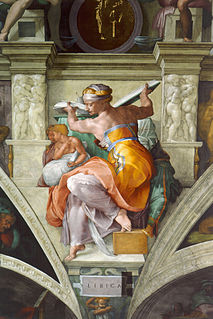
The Libyan Sibyl, named Phemonoe, was the prophetic priestess presiding over the Oracle of Zeus-Ammon at Siwa Oasis in the Libyan Desert.
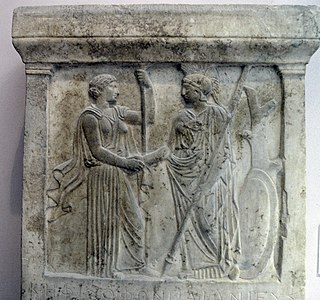
Duris of Samos was a Greek historian and was at some period tyrant of Samos. Duris was the author of a narrative history of events in Greece and Macedonia from 371 BC to 281 BC, which has been lost. Other works included a life of Agathocles of Syracuse and a number of treatises on literary and artistic subjects.

Samos is a Greek island in the eastern Aegean Sea, south of Chios, north of Patmos and the Dodecanese, and off the coast of western Turkey, from which it is separated by the 1.6-kilometre (1.0 mi)-wide Mycale Strait. It is also a separate regional unit of the North Aegean region, and the only municipality of the regional unit.
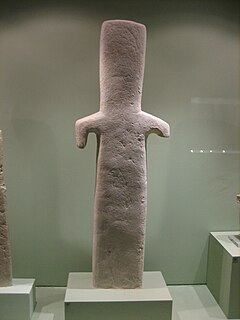
A xoanon was an Archaic wooden cult image of Ancient Greece. Classical Greeks associated such cult objects, whether aniconic or effigy, with the legendary Daedalus. Many such cult images were preserved into historical times, though none are known to have survived to the modern day, except as copies in stone or marble. In the 2nd century CE, Pausanias described numerous xoana in his Description of Greece, notably the image of Hera in her temple at Samos. "The statue of the Samian Hera, as Aethilos [sic] says, was a wooden beam at first, but afterwards, when Prokles was ruler, it was humanized in form". In Pausanias' travels he never mentions seeing a xoanon of a "mortal man".
Philipof Opus, was a philosopher and a member of the Academy during Plato's lifetime. Philip was the editor of Plato's Laws. Philip of Opus is probably identical with the Philip of Medma, the astronomer, who is also described as a disciple of Plato.
Bryson of Achaea was an ancient Greek philosopher.
Pythagoras of Samos or Pythagoras of Rhegion was a sculptor from Samos whom Pliny the Elder expressly distinguishes from the more renowned Pythagoras the mathematician, from Rhegium. Pliny does however say that the sculptor bore a remarkable personal likeness to the mathematician. There is no precise indication of his date. Philip Smith accepted the opinion of Karl Julius Sillig (1801—1855) that Pliny's date of Olympiad 87 ought to be referred to this artist rather than to a different Pythagoras, from Rhegium; other writers consider it possible he lived closer to the beginning of the 5th century BC. Modern writers consider it certain these two were the same artist, and that this Pythagoras was one of the Samian exiles who moved to Zankle at the beginning of the 5th century BC and came under the power of the tyrant Anaxilas in Rhegium. While a Samian by birth, he was a pupil of Clearchus of Rhegium.
Heraeum or Heraion, also known as Heraion Teichos was a Greek city in ancient Thrace, located on the Propontis, a little to the east of Bisanthe. The city was a Samian colony and founded around 600 BC. In some of the Itineraries, the place is called Hiereum or Ereon.
Themistoclea Names such as Diotima, Aesara, Aristoclea, Hiparchia, Theano, Areté, Sosipatra, Porcia, and Hypatia, She is also considered one of the first European philosophers, though none of her works didn't seem to survive since the 6th century.

Marpessos was a settlement in the middle Skamander valley of the Troad region of Anatolia. The settlement's name is also spelled Μαρμησσ�/p>
Annaea or Annaia or Anaea or Anaia (Ἀναία), was a town of ancient Ionia. It is placed by Stephanus of Byzantium in Caria, and opposite to Samos. Pausanias also puts it on the mainland across from Samos and says it was fortified by the people of that island after being displaced by Androklos of Ephesos. After ten years of mustering forces at Anaia, they were able to launch a force back across and reclaim Samos. Ephorus says that it was so called from an Amazon Anaea, who was buried there. If Anaea was opposite Samos, it must have been in Ionia, which did not extend south of the Maeander River. From the expressions of Thucydides, it may have been on or near the coast, and in or near the valley of the Maeander. Some Samian exiles posted themselves here in the Peloponnesian War. The passage of Thucydides seems to make it a naval station, and one near enough to annoy Samos.
The Geomori were a group of wealthy aristocrats who ruled Samos as an oligarchy in the seventh or sixth century BC. They remained an important political group on Samos into the fifth century BC.















